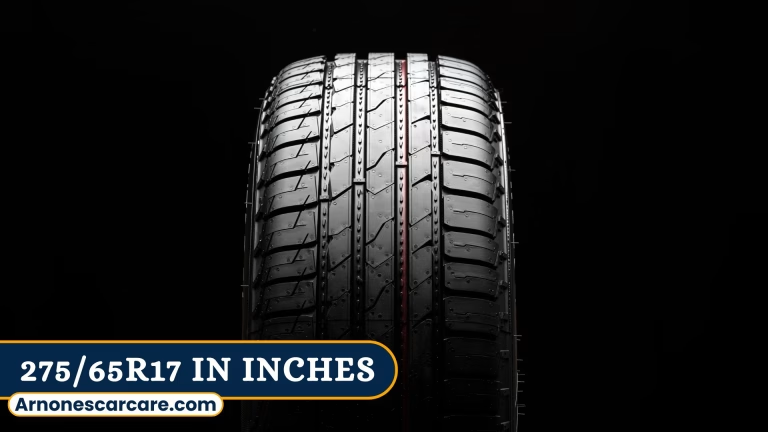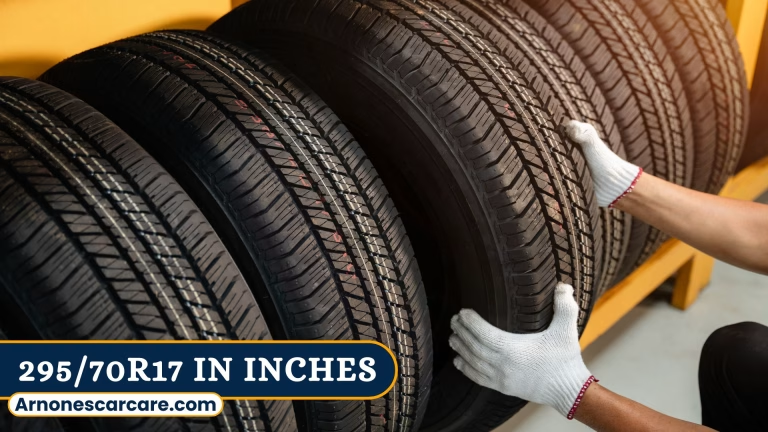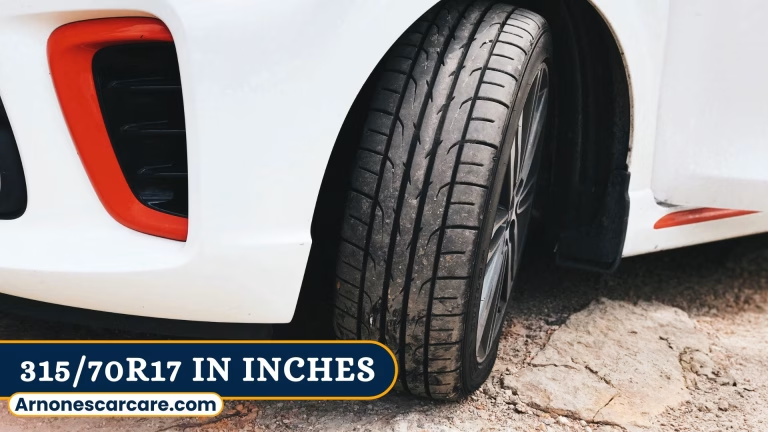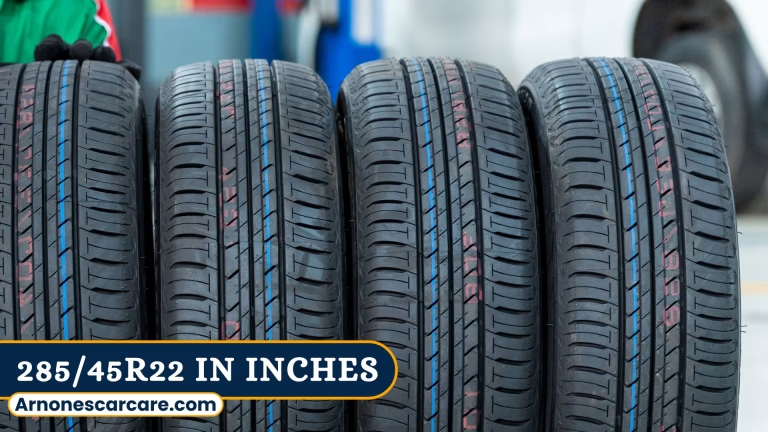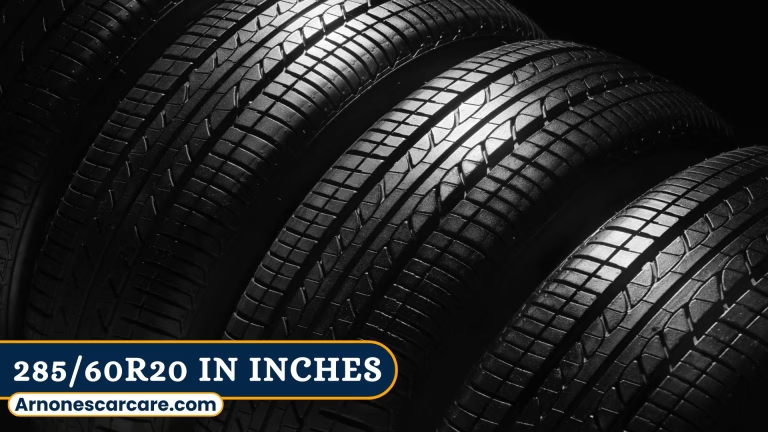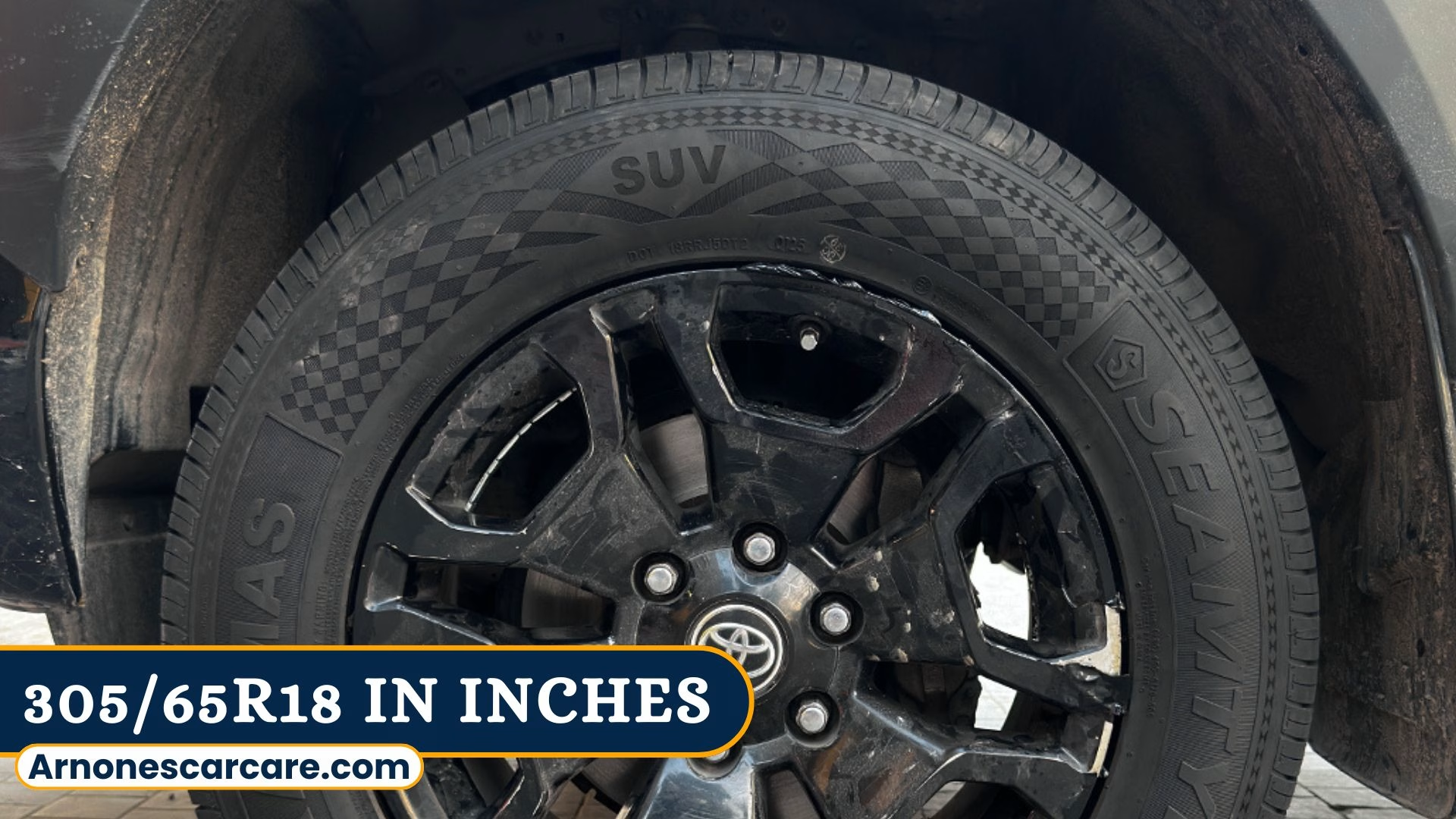
The 305/65R18 tire comes with an overall diameter of 33.6 inches (853 mm), a tread width of 12 inches (305 mm), and is designed for 18-inch (457 mm) wheels. It features a sidewall height of 7.8 inches (198 mm) and a circumference of 105.4 inches (2676 mm), resulting in roughly 600 revolutions per mile (373 per kilometer).
With its wide stance and strong traction, this tire size delivers dependable handling on paved roads while offering excellent capability for off-road use.
You can explore more about tire sizes on our blog for better understanding and selection.
Tire Dimensions: 305/65R18 in Inches & Millimeters
The 305/65R18 tire comes with specific measurements that impact vehicle performance. Below is a breakdown of its key dimensions:

| Measurement | In Inches | In Millimeters (mm) |
| Overall Diameter | 33.6 inches | 853 mm |
| Tire Width | 12 inches | 305 mm |
| Rim Size | 18 inches | 457.2 mm |
| Sidewall Height | 7.8 inches | 198 mm |
| Tire Circumference | 105.5 inches | 2678.4 mm |
| Revolutions Per Mile | 601 revs | 373 revs/km |
Why do These Numbers Matter?
- Larger diameter means better ground clearance.
- Wider tire width improves traction and stability.
- Sidewall height affects ride comfort and handling.
- Circumference and revolutions per mile impact speedometer accuracy.
These dimensions help determine if 305/65R18 is the right fit for your driving needs, whether for daily commuting, off-roading, or highway cruising.
What Do the Numbers in 305/65R18 Mean?
Let’s break down each part of the 305/65R18 tire size:
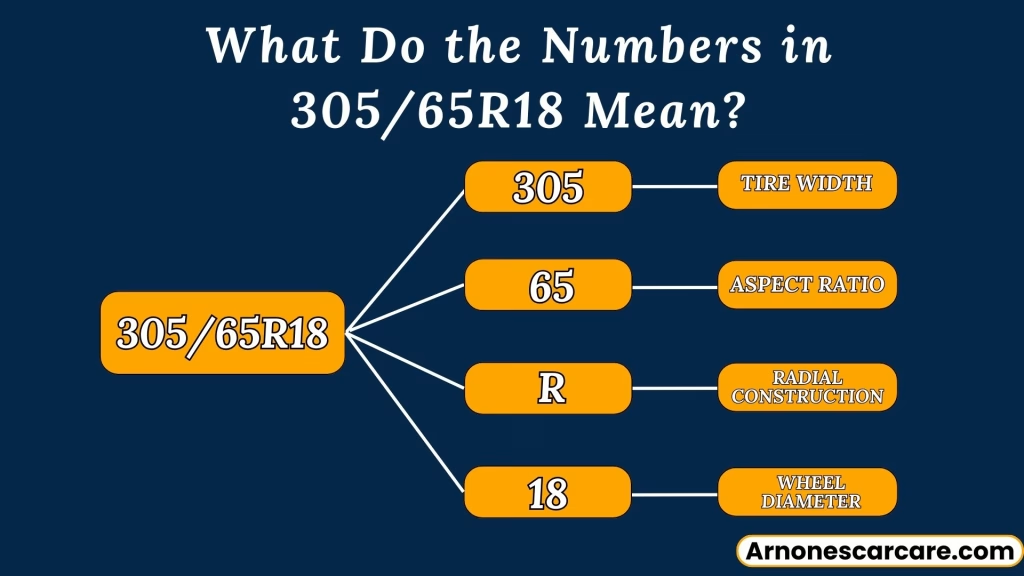
- 305: This is the tire width in millimeters. When converted, it’s about 12 inches wide.
- 65: This is the aspect ratio, meaning the sidewall height is 65% of the tire’s width.
- R: The “R” stands for Radial construction, which is the most common type used in modern vehicles.
- 18: This tells you that the tire is designed to fit a wheel with an 18-inch diameter.
Now that you know how to read this tire size, you’re better equipped to choose the right tires for your vehicle.
Converting 305/65R18 into Inches: A Simple Guide
If you’re wondering how 305/65R18 translates into inches, the process is pretty straightforward. Here’s a step-by-step breakdown of how to convert each part of the tire size:
- Convert Width (305 mm to inches):
- There are 25.4 millimeters in an inch.
- 305 ÷ 25.4 ≈ 12 inches (this is the tire width).
- Calculate Sidewall Height:
- The aspect ratio (65) means the sidewall height is 65% of the tire width.
- 12 inches × 0.65 = 7.8 inches (sidewall height).
- Determine the Overall Diameter:
- Add the wheel diameter (18 inches) plus two sidewalls (7.8 × 2).
- 7.8 + 7.8 + 18 = 33.6 inches (total tire diameter).
- Calculate Circumference:
- Use the formula Circumference = Diameter × π (3.1416).
- 33.6 × 3.1416 ≈ 105.5 inches.
- Revolutions Per Mile:
- To find how many times the tire rotates per mile:
- 63360 ÷ 105.5 ≈ 601 revolutions per mile.
💡 Why Can Measurements Vary?
While these calculations provide an accurate estimate, real-world measurements may differ slightly due to manufacturer design, tread depth, and inflation levels.
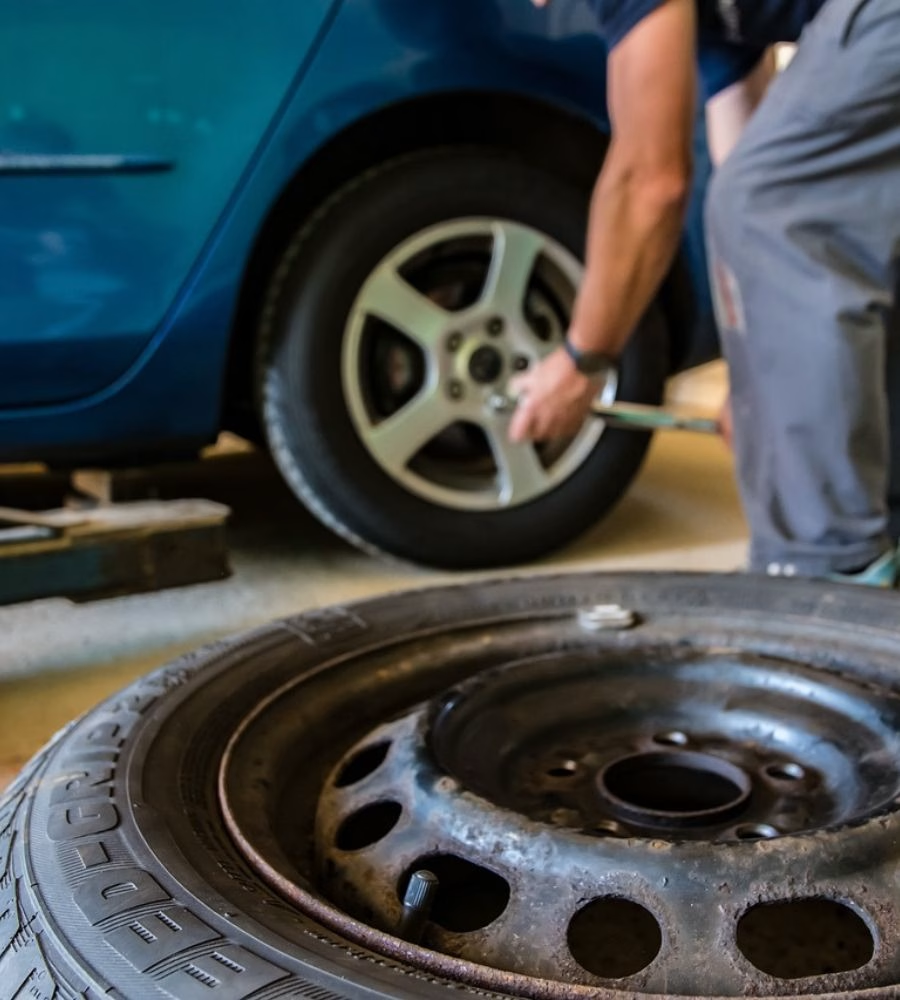
How Often Should I Rotate 305/65R18 Tires?
To keep your 305/65R18 tires wearing evenly and lasting longer, it’s recommended to rotate them every 5,000 to 7,500 miles (or roughly every oil change). Tire rotation helps distribute tread wear more evenly across all four tires, preventing excessive wear on just the front or rear ones.
Why Is Tire Rotation Important?
Tire rotation is an essential aspect of vehicle maintenance that helps ensure even tire wear, improve handling and safety, and extend the lifespan of your tires. Here are the key reasons why tire rotation is important:
- Even Tread Wear: Since front tires wear out faster due to steering and braking forces, rotating them ensures balanced wear.
- Improved Handling & Safety: Unevenly worn tires can cause vibrations, poor traction, and handling issues.
- Extended Tire Life: Regular rotation helps get the most mileage out of your tires, saving you money in the long run.
Comparing 305/65R18 to Other Popular Tire Sizes
If you’re debating between 305/65R18 and other common tire sizes, here’s how they stack up:
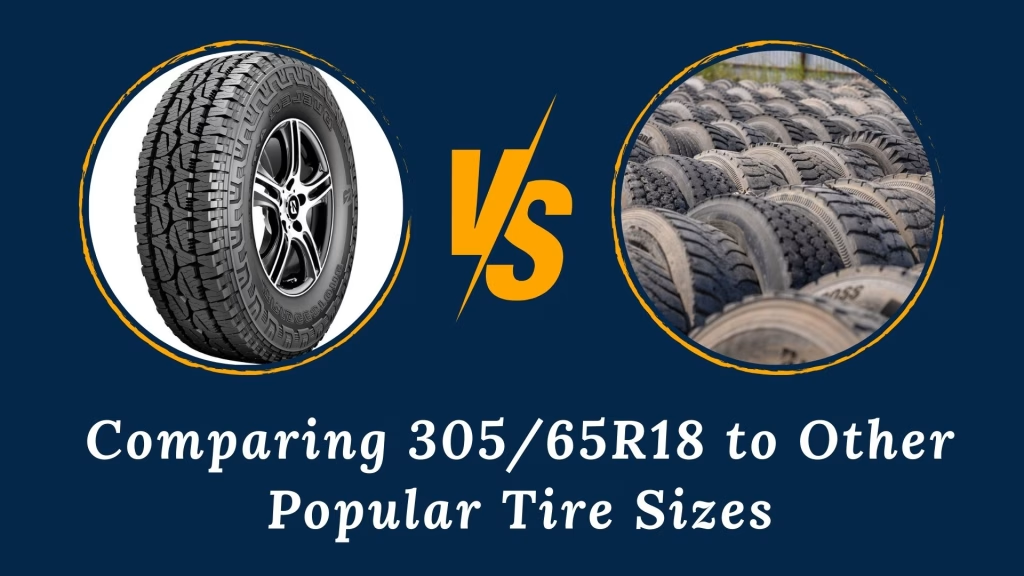
305/65R18 vs. 285/75R16
| Feature | 305/65R18 | 285/75R16 |
| Width | 12 inches | 11.2 inches |
| Height | 33.6 inches | 33.8 inches |
| Sidewall | 7.8 inches | 8.4 inches |
Key Differences:
- 285/75R16 is slightly taller (33.8″) but narrower (11.2″).
- 305/65R18 is wider, which means better traction and stability.
- 285/75R16 has a taller sidewall, which may offer a softer ride on rough roads.
305/65R18 vs. 315/70R17
| Feature | 305/65R18 | 315/70R17 |
| Width | 12 inches | 12.4 inches |
| Height | 33.6 inches | 34.4 inches |
| Sidewall | 7.8 inches | 8.7 inches |
Key Differences:
- 315/70R17 is wider (12.4″) and taller (34.4″), providing more ground clearance.
- 305/65R18 offers better fuel efficiency and handling on highways.
- 315/70R17 may work better for extreme off-road conditions due to added height.
Which Tire Size is Best for You?
- If you want better fuel economy, handling, and all-around performance, 305/65R18 is a great choice.
- If you do heavy off-roading and need extra ground clearance, 315/70R17 might be the better pick.
- If you want a balance of durability and comfort with a taller sidewall, 285/75R16 could work well.
Final Thoughts
Now that you understand the 305/65R18 tire size, its benefits, and how to choose the right type, you’re ready to make an informed decision. Whether you’re upgrading for better off-road performance, improved traction, or durability, picking the right tires ensures a safer and smoother ride.
Before purchasing, consider your driving habits, terrain, and load requirements to find the best match. A well-chosen set of tires not only enhances vehicle performance but also extends tire lifespan and improves safety.
Need help to select the perfect 305/65R18 tires? Consult with a professional tire dealer to get the best option for your vehicle. You can also get professional tire repair services here to keep your tires in top condition.
FAQs
Q. Are 305/65R18 tires good for off-road driving?
Yes! They offer great traction and durability on rough terrains, especially mud-terrain (MT) and all-terrain (AT) versions.
Q. Do 305/65R18 tires fit all 18-inch wheels?
Not necessarily. While they fit 18-inch rims, you must check for proper clearance and compatibility with your vehicle’s suspension.
Q. Are wider tires like 305/65R18 better for stability?
Yes, wider tires provide better road grip and handling, but they can slightly reduce fuel efficiency.

